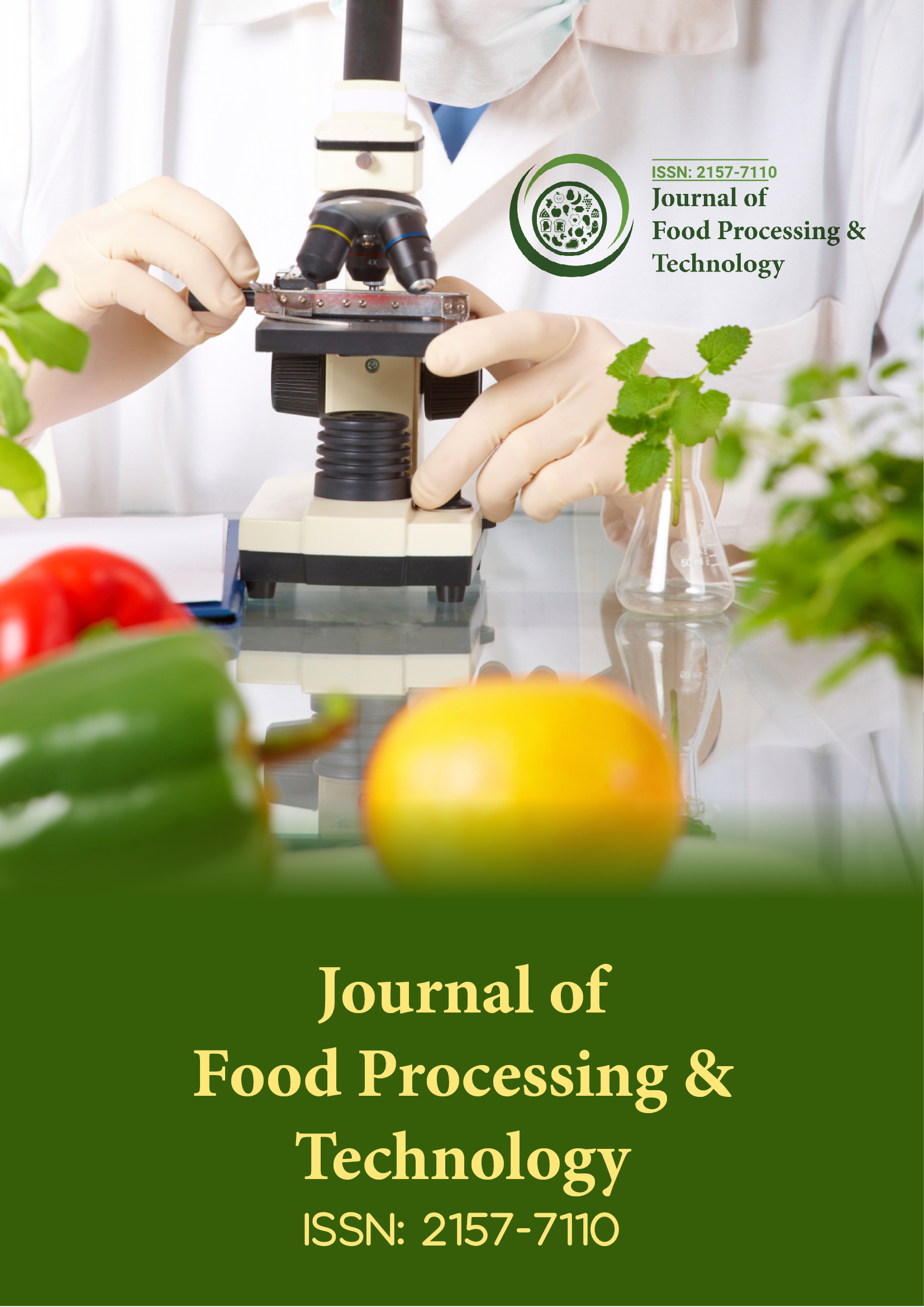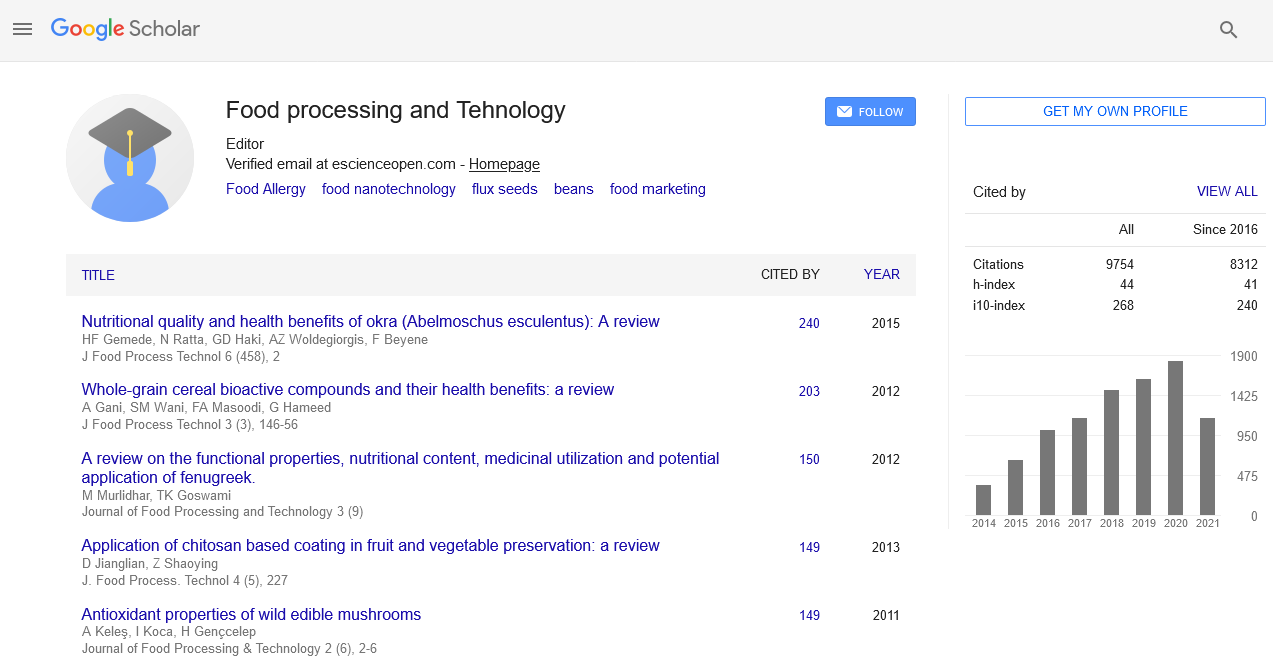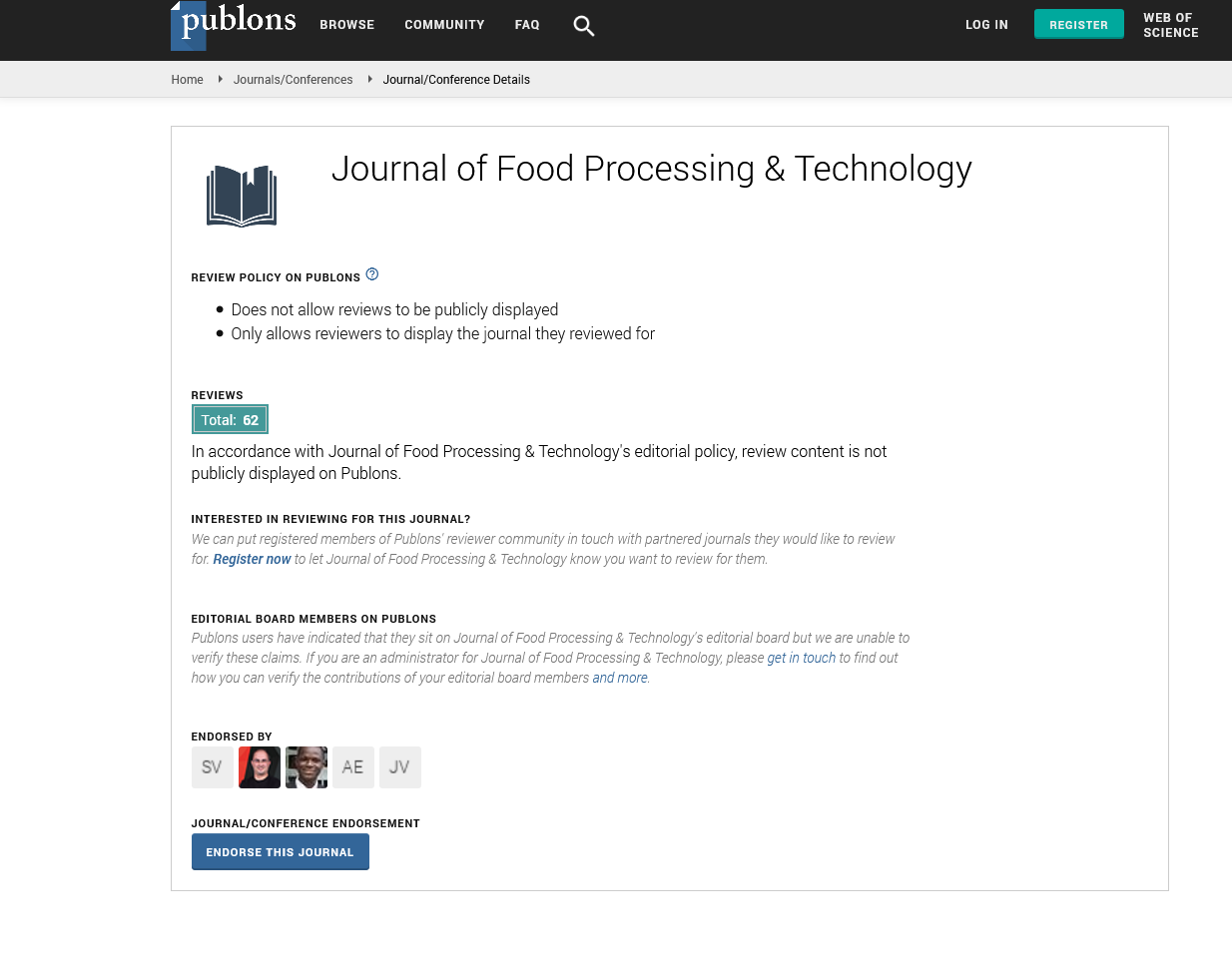Indexed In
- Genamics JournalSeek
- Academic Keys
- JournalTOCs
- China National Knowledge Infrastructure (CNKI)
- Access to Global Online Research in Agriculture (AGORA)
- Centre for Agriculture and Biosciences International (CABI)
- RefSeek
- Directory of Research Journal Indexing (DRJI)
- Hamdard University
- EBSCO A-Z
- OCLC- WorldCat
- Scholarsteer
- SWB online catalog
- Publons
- Euro Pub
- Google Scholar
Useful Links
Share This Page
Journal Flyer

Open Access Journals
- Agri and Aquaculture
- Biochemistry
- Bioinformatics & Systems Biology
- Business & Management
- Chemistry
- Clinical Sciences
- Engineering
- Food & Nutrition
- General Science
- Genetics & Molecular Biology
- Immunology & Microbiology
- Medical Sciences
- Neuroscience & Psychology
- Nursing & Health Care
- Pharmaceutical Sciences
Opinion Article - (2025) Volume 16, Issue 1
Sustainable Packaging Innovations in Food Processing Industry
Thomas Becker*Received: 27-Jan-2025, Manuscript No. JFPT-25-29178; Editor assigned: 29-Jan-2025, Pre QC No. JFPT-25-29178; Reviewed: 12-Feb-2025, QC No. JFPT-25-29178; Revised: 18-Feb-2025, Manuscript No. JFPT-25-29178; Published: 26-Feb-2025, DOI: 10.35248/2157-7110.25.16.1145
Description
Encapsulation technologies have emerged as a critical innovation in the field of functional food development, particularly for the effective delivery of bioactive compounds. Bioactive compounds, which include vitamins, antioxidants, polyphenols, omega-3 fatty acids, probiotics and plant extracts, offer significant health benefits beyond basic nutrition. However, their direct incorporation into food systems often presents challenges due to instability during processing and storage, poor water solubility, sensitivity to heat, light and oxygen and low bioavailability in the gastrointestinal tract. Encapsulation provides a strategic solution to these limitations by entrapping bioactives within a carrier material, thereby protecting them from environmental degradation, masking undesirable tastes or odors and enabling controlled release at the target site within the human body.
Encapsulation involves the entrapment of active ingredients within a matrix or shell material, forming microcapsules or nanocapsules, depending on the particle size. A wide range of wall materials are employed, including polysaccharides (such as alginate, pectin, starch and chitosan), proteins (such as gelatin, casein and whey protein), lipids (such as waxes and fatty acids), or combinations of these materials. The choice of encapsulating agent depends on the nature of the bioactive compound, the intended release mechanism, compatibility with the food matrix and the processing conditions. These carriers not only provide physical protection but also control the release kinetics of the core material during digestion or in response to environmental triggers such as pH, temperature, or enzymatic activity.
Among the commonly used encapsulation techniques, spray drying is one of the most prevalent in the food industry due to its cost-effectiveness, scalability and compatibility with heat-stable bioactives. In spray drying, an emulsion or solution containing the bioactive compound and wall material is atomized into a hot chamber, where rapid solvent evaporation leads to the formation of dry microcapsules. While this method is efficient, it may not be suitable for thermally sensitive compounds like probiotics or certain vitamins, which may degrade at high temperatures. To address this limitation, alternative methods such as freeze drying, coacervation, emulsification, extrusion and liposomal encapsulation are employed, each with its own advantages in preserving compound integrity and enhancing bioavailability.
Liposomes, for instance, are spherical vesicles composed of one or more phospholipid bilayers that encapsulate both hydrophilic and hydrophobic compounds. Due to their structural similarity to biological membranes, liposomes are highly biocompatible and are particularly useful for delivering sensitive compounds such as polyunsaturated fatty acids, curcumin, or certain enzymes. Liposomal encapsulation can enhance absorption in the gastrointestinal tract and promote targeted delivery, making them an attractive option for nutraceuticals and fortified foods.
Another widely researched approach is nanoencapsulation, which involves reducing the encapsulated particles to nanometer-scale dimensions. Nanoencapsulation significantly improves the solubility, stability and bioavailability of poorly soluble bioactives. Nanoparticles, nanoemulsions and nanofibers can be produced using high-pressure homogenization, ultrasonication, or electrospinning techniques. These nano-sized carriers offer a large surface-area-to-volume ratio, enhancing the interaction with biological systems and facilitating absorption across intestinal barriers. For example, the encapsulation of curcumin in nanoemulsions has shown increased antioxidant activity and bioavailability compared to its free form.
Encapsulation also plays a vital role in the delivery of probiotics, which are live microorganisms that confer health benefits when consumed in adequate amounts. Probiotic bacteria are sensitive to heat, oxygen, moisture and acidic conditions in the stomach. Microencapsulation using alginate, gelatin, or chitosan matrices can significantly enhance their viability during food processing and storage and ensure their survival during passage through the gastrointestinal tract. This ensures that a sufficient number of live cells reach the intestine to exert their beneficial effects, such as improving gut health, modulating immune response and inhibiting pathogenic bacteria.
Controlled release is another significant advantage of encapsulation technologies. The encapsulating material can be engineered to release the bioactive compound at a specific time or site in the digestive tract. For instance, pH-sensitive polymers can be used to protect the compound in the acidic environment of the stomach and release it in the more neutral pH of the intestines, where absorption is more efficient. This targeted delivery not only maximizes the functional impact of the compound but also reduces potential side effects or interactions with other food components.
Despite the numerous benefits, there are challenges associated with the integration of encapsulated bioactives into food systems. The physical and chemical compatibility of the encapsulated compound with the food matrix, the impact on sensory attributes such as taste, texture and appearance and the regulatory approval for encapsulating agents all play critical roles in determining the commercial viability of such products. Moreover, the cost of encapsulation technologies and the need for specialized equipment may pose limitations for widespread adoption, particularly among small- and medium-sized enterprises.
Ongoing research continues to address these challenges by developing novel materials and methods that are more efficient, cost-effective and compatible with large-scale food production. Emerging trends include the use of biopolymer blends, multifunctional encapsulation systems that deliver more than one bioactive compound and intelligent delivery systems that respond to physiological conditions for precision nutrition. Furthermore, advances in material science, nanotechnology and food engineering are expected to expand the scope of encapsulation applications, making them an integral part of next-generation functional foods.
In conclusion, encapsulation technologies offer a powerful tool for improving the stability, functionality and targeted delivery of bioactive compounds in food systems. By overcoming the inherent limitations of free bioactives, encapsulation enhances the effectiveness of health-promoting ingredients, paving the way for the development of advanced functional and fortified foods. As consumer awareness of nutrition and wellness continues to grow, the demand for encapsulated bioactives in food is expected to rise, driving further innovation and integration of these technologies in the food industry.
Citation: Becker T (2025). Sustainable Packaging Innovations in Food Processing Industry. J Food Process Technol.16: 1145.
Copyright: © 2025 Becker T. This is an open access article distributed under the terms of the Creative Commons Attribution License, which permits unrestricted use, distribution and reproduction in any medium, provided the original author and source are credited.


